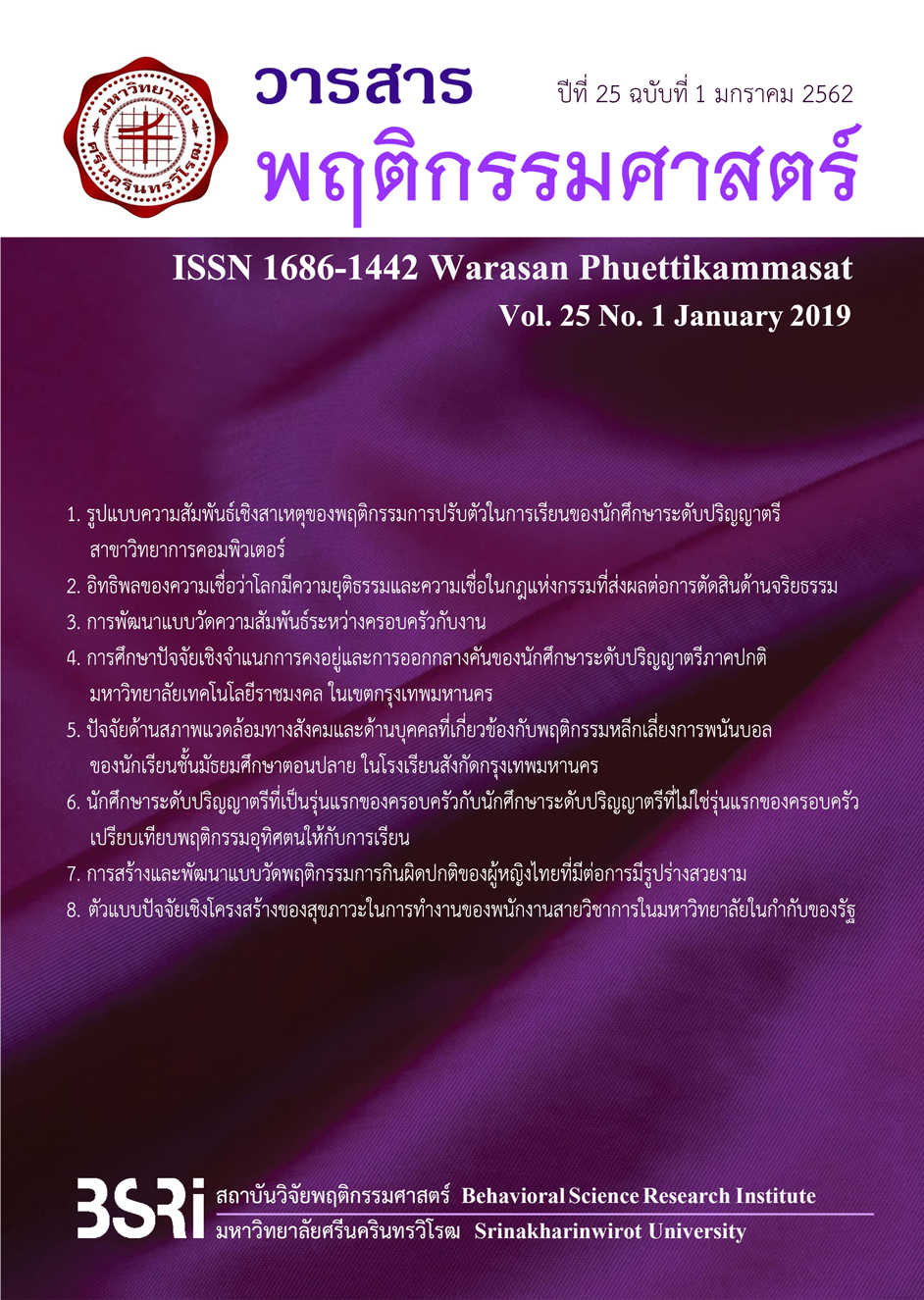การพัฒนาแบบวัดความสัมพันธ์ระหว่างครอบครัวกับงาน
Keywords:
Work-family interface inventory, work-family facilitation, work- family conflict, psychometric propertiesAbstract
The purposes of this study were to develop valid and reliable and verify dimensions of work-family interface. The sample consisted of 466 teachers in Bangkok. The major instrument was work-family interface inventory that contained 36 items. Each item was rated on a five-point Likert scale, from (1) never true of me to (5) always true of me. The data were analyzed using confirmatory analysis. The results showed that there were two separate dimensions of work-family interface: work-family facilitation and work-family conflict. Both the model with six firth-order correlated factors of facilitation/conflict and the model with two correlated second-order factors of work-family facilitation (family-to-work facilitation and work-to-family facilitation) /work-family conflict (family-to-work conflict and work-to-family conflict) showed a good fit to empirical data. Specifically, the six factors of work-family facilitation/work-family conflict included the combination of three types of work-family facilitation (affect, characteristic, behavior)/work-family conflict (time, stress, behavior) and two directions of work-family facilitation/ work-family conflict (family-to-work and work-to-family). The results indicated that the work-family interface inventory had good psychometric properties: internal consistency reliability (α = .86 - .93), convergent (AVE = .68 - .81) and discriminant validity (MSV = 057 - .66). The measure of work-family interface is a multidimensional scale that has the potential for significant usage in the development and testing of theory, as well as practical application.
Keywords: Work-family interface inventory, work-family facilitation, work- family conflict, psychometric properties
Downloads
References
Carlson, D. S., Kacmar, K. M., Wayne, J. H., & Grzywacz, J. G. (2006). Measuring the positive side of the work–family interface: Development and validation of a work–family enrichment scale. Journal of Vocational Behavior. 68, 131 – 164.
Choochom, O. (2016). The influence of psycho-social factors on work-family facilitation. Journal of Psychology Kasem Bundit University, 6(1), 11-23.
Choochom, O. Sucaromana, A. & Intarakamhang, U. (2010). kān wikhro̜ khwāmsamphan rawāng khrō̜pkhrūa - ngān kap khunnaphāp chīwi] [An analysis of work-family linkage and quality of life]. Warasan Phuettikammasat, 16(2), 32-49.
Crowley, S. L. & Fan, X. (1997). Structural equation modeling. In J. Shinka & G. Curtis (Eds.) Emerging Issues and Methods in Personality Assessment. (pp. 285-308). Hillsdale, NJ: Lawrence.
Edwards, J. R. & Rothbard, N. P. (2000). Mechanism linking work and family: Clarifying the relationship between work and family construct. Academy of Management Review, 25(1), 178–199.
Frone, M. R. (2003). Work-family balance. In J. C. Quick & L. E. Tetrick (Eds.). Handbook of occupational health psychology (pp. 143-162). Washington, DC: American Psychological Association.
Ghisliert, C., Martini, M., Gatti, P., & Colombo., L. (2011). The “bright side” of the work-family
interface: A brief work-family enrichment scale in a sample of health professionals. TPM-
Testing, Psychometrics, Methodology in Applied Psychology, Vol. 17(4), 211-230.
Greenhaus, J.H. & Beutell, N.J. (1985). Sources of conflict between work and family roles. Academy of Management, 10, 76 – 88.
Greenhaus, J. H. & Powell, G. N. (2006). When work and family are allies: A theory of work – family enrichment. Academy of Management Review, 31, 79–92.
Grzywacz, J, S. & Marks, N.F. (2000). Reconceptualizing the work– family interface: An ecological perspective on the correlates of positive and negative spillover between work and family. Journal of Occupational Health Psychology, 5, 111–126.
Hair, J., Black, W., Babin, B., & Anderson, R. (2010). Multivariate data analysis. Prentice-Hall:
NewYork.
Hanson, G.L. et al. (2006). Development and validation of multi dimensional scale of perceived work – family positive spillover. Journal of Occupational Health Psychology, 11(1), 249 – 265.
Hill, E.J. (2005). Work – family facilitation and conflict, working fathers and mothers, work–family stressors and support. Journal of Family Issues, 26(6), 793–819.
Kaewkiattikun, K. (2009). pati samphan rawāng ngān læ khrō̜pkhrūa khō̜ng phayābān wichāchīp [Work-family interaction of registered nurses]. Thai Human Resource Research Journal, 4(1), 13-31.
Netemeyer, R. G., Boles, J. S., & McMurrian, R. (1996). Development and validation of work-family conflict and family-work conflicts scales. Journal of Applied Psychology, 81(4). 400-410.
Wayne, J., Musisca, N., & Fleeson, W. (2004). Considering the role of personality in the work-
family experience: Relationship of the big five to work-family conflict and facilitation.
Journal of Vocational Behavior, 64, 108-130.
Vieria, J. M., Lopez, F. G., & Matos, P. M. (2014). Further validation of work-family conflict and
Work - family enrichment scales among Portuguese working parents. Journal of Career
Assessment, 22(2), 319-344.
Voydanoff, P. (2005). Work demands and work–to–family and family-to-work conflict:
Direct and indirect relationships. Journal of Family Issues, 26(6), 707–726.
Downloads
Published
How to Cite
Issue
Section
License
Behavioral Science Research Institute, SWU
114 Sukhumvit 23, Bangkok 10110, Thailand.
Tel.02-649-5000 # 17600



